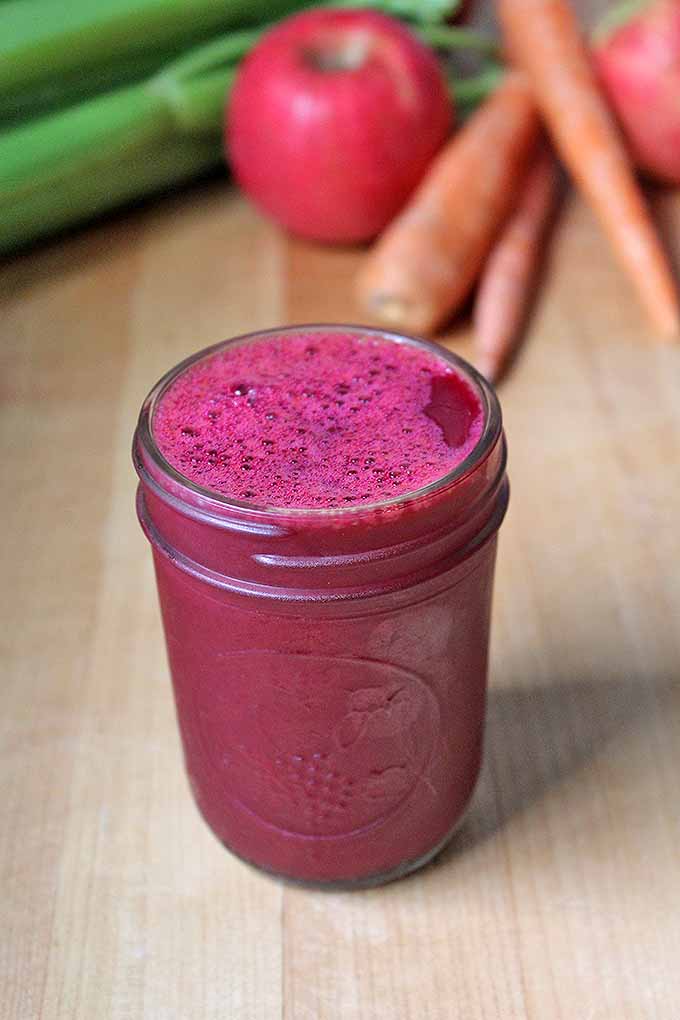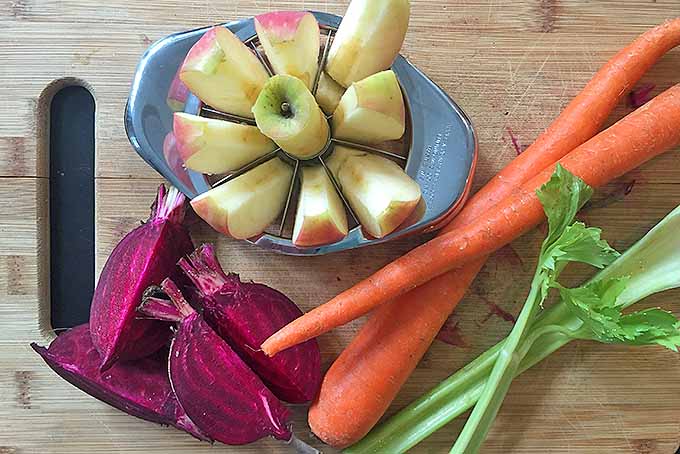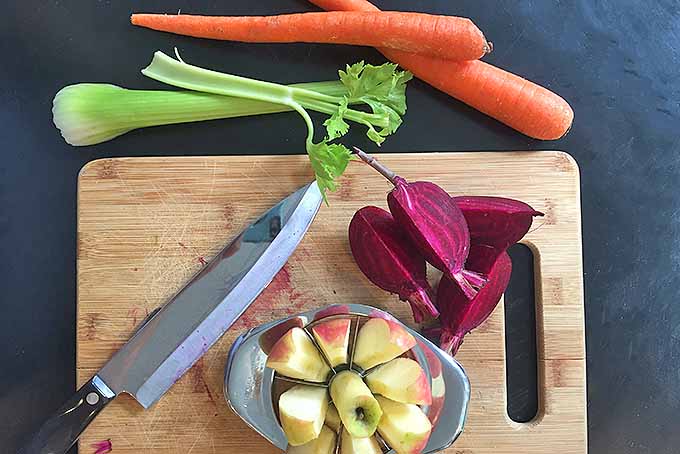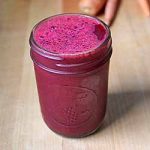Jump to the Recipe
There’s no better way to start the day than with a glass of homemade fruit and vegetable juice.

You’re going to love this easy recipe. In addition to being refreshing and delicious, each ingredient has potential health benefits. Let’s see what they are, and then it’s on to the recipe!
Amazing Apples
An apple a day, right?
Apples are rich in phytonutrients and antioxidants. And they come in a wide variety from the sweet Honeycrisp to the tart Granny Smith.
Whether eaten whole, diced in a salad, or baked, this fruit is widely available and enjoyed by many.

Using it to add a bit of sweet and tart flavor to homemade juices is a great way to easy into becoming a daily juicer at home, at least until you’re more used to the flavor of fresh, healthy greens and vegetables and less reliant on sugar-rich fruits.
General Tips
Select apples that are firm, shiny, and free of blemishes, holes, and discoloration. Store in the refrigerator, or on the counter if you will be eating them right away.
Before adding your apples to the chute of your juicer, be sure to remove the stems and seeds first. Apple seeds contain a small quantity of arsenic, and ingesting them is not advised.
Potential Health Benefits
- Immune health support
A Good Source of:
- Vitamin C
Beautiful Beets
Beets contain a significant number of antioxidants, and the green, leafy tops are rich in beta-carotene. These beautiful greens as well as the roots are delicious in many types of recipes, like salads or a quick vegetable sauté, as well as fresh beverages.

General Tips
When choosing beets, avoid large and rough skinned ones. Small to medium-sized beets with smooth skin, firm roots, and a beautiful dark color are the best. Avoid those with bruises and soft spots.
While raw beets are mostly water and carbohydrates, they also contain a small amount of protein.
Potential Health Benefits
- Support blood flow
- Support bone health
An Excellent Source of:
- Potassium
A Good Source of:
- Calcium
Crunchy Carrots
Carrots are a well-loved vegetable that is delicious both raw and cooked in a wide variety of dishes.
They come in a variety of colors, each with its own subtle flavor differences, but they all share the same characteristic sweetness.

Rich in antioxidants, Vitamin A, and beta-carotene, consuming carrots and other brightly-colored vegetables containing carotenoids may support eye health.
General Tips
When you purchase carrots, look for those that are firm, free of blemishes, splits, and discoloration. I like to buy the narrowest ones I can find, as they are younger and sweeter than large ones. Carrots may be purchased with or without tops.
At home, remove the tops and place carrots in an airtight container with about an inch of water in the bottom. If you change the water daily, they should stay fresh for about a month.
Potential Health Benefits
- Support eye health
- Aid digestion
A Good Source of:
- Potassium
Crisp Celery
High in fiber, phytonutrients, and sodium, celery is mostly water, and very low in calories. Its ribs, heart, leaves, root, and seeds all offer nutritional benefits.
Celery also contains antioxidants that may reduce inflammation and fight free radicals to reduce the risk of cancer.

General Tips
Choose celery that is crisp and firm. It should snap in half easily if you bend it.
Check the leaves as well – they should be light to dark green, and never yellow or brown.
To preserve its antioxidant qualities, celery should be stored in the fridge and used within one week of purchase.
Cut celery sticks may be stored with just enough water to cover them in a tight-lidded container. Be sure to change the water if you don’t use them up the first day.
Potential Health Benefits
Contains natural sodium (a little is necessary, even for a low-sodium diet)
May aid in reducing blood pressure
An Excellent Source of:
- Potassium
- Vitamin A
Super Spirulina
Spirulina is a blue-green saltwater algae that’s rich in nutrients. It is consumed as a nutritional supplement in tablet or powdered form.
Called a “superfood,” it is considered a complete protein, meaning it contains all the essential amino acids.
Spirulina is a popular addition to homemade beverages because a small amount adds a significant source of desirable nutrients like protein, iron, and vitamin A.

General Tips
Store in an airtight container in the fridge for up to six months, or according to package instructions.
Potential Health Benefits
- May contribute to lower LDL and increased HDL cholesterol
- May help lower risk of certain cancers
- Supports good dental health
- Supports good vision
An Excellent Source of:
- Beta-carotene
- Iron
- Manganese
- Omega-3 fatty acids
- Protein
- Vitamin A
- Vitamin B12
- Vitamin K
The Recipe
- 1 apple
- 1 small beet with greens
- 2 large carrots
- 1 stalk of celery,
- 1 teaspoon spirulina (optional)
- Scrub the vegetables, and remove the stem and the seeds from the apple.
- Put ingredients through the chute of your juicer and juice according to manufacturer’s directions.
- Stir, and drink immediately.
Recipe by Lori Hendrix.
Nutritional Information*
So Many Possibilities
There’s no better way to get your body going in the morning than with a refreshing beverage made with nutritious fruits and vegetables. Start with your favorites, and branch out to those you’ve never tried before.
If you like this recipe, you’ve got to try our Spinach Apple Juice.
Have you ever tried dandelion greens? Look for them in your grocery store in spring and summer, and try whipping up a glass of Jolly Green Juice. You’ll love the tangy turmeric and ginger!
Try a different blend every day!

What’s your favorite homemade fruit and vegetable drink? We’d love to hear about it in the comments section below.
The staff at Foodal are not medical professionals and this article should not be construed as medical advice. Foodal and Ask the Experts, LLC assume no liability for the use or misuse of the material presented above. Always consult with a medical professional before changing your diet, or using supplements or manufactured or natural medications.
Uncredited photos by Kendall Vanderslice, © Ask the Experts, LLC. ALL RIGHTS RESERVED. See our TOS for more details. Spiraling photo: Shutterstock. Significantly revised and expanded from a post originally written by Lori Hendrix, with additional writing and editing by Allison Sidhu.
*Nutritional information derived from a database of known generic and branded foods and ingredients and was not compiled by a registered dietitian or submitted for lab testing. It should be viewed as an approximation.
About Nan Schiller
Nan Schiller is a writer from southeastern Pennsylvania. When she’s not in the garden, she’s in the kitchen preparing imaginative gluten- and dairy-free meals. With a background in business, writing, editing, and photography, Nan writes humorous and informative articles on gardening, food, parenting, and real estate topics. Having celiac disease has only served to inspire her to continue to explore creative ways to provide her family with nutritious locally-sourced food.







There is some great information on apples in this article! I did not know the apple originated in Kazakhstan. The apple has many health benefits, but unfortunately, I don’t think I could eat one on an empty stomach. For some reason, it upsets my stomach if I do that. These recipes look wonderful, especially the apple pie. I have to try it. Thank you for sharing.
Apple juice is manufactured by a process of maceration and the pressing of apples which may be further treated to remove the pectin and starch, then pasteurized for packing or dehydrated for concentrate. The majority of nutrients are lost in the processing and some have “added vitamin C” which basically means that manufacturers are adding a nutrient which has been removed from the apple in the processing.